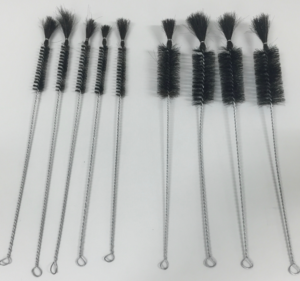“Test tube brushes are essential tools in a science lab. They are used to clean test tubes and other glassware, which is crucial to prevent contamination of samples and ensure the accuracy of results.”
The brushes come in various sizes, materials, and designs, and scientists can select the appropriate one for the type of glassware being cleaned. This article will explore the uses of test tube brushes, their features, and effective ways of using them.

What is a test tube brush used for in science, and Why?
Designers make test tube brushes for cleaning test tubes, flasks, beakers, and other laboratory glassware. A clean piece of laboratory equipment is essential for obtaining accurate results in scientific experiments. Here are ten reasons why test tube brushes are vital tools in the laboratory:
- Scientists use test tube brushes to clean test tubes and other glassware to prevent sample contamination, which may compromise result accuracy.
- They help remove any stubborn debris, stains, or residue that may be difficult to remove with soap and water alone.
- Test tube brushes can reach hard-to-reach areas that are difficult to clean by hand, such as narrow necks and corners.
- They help save time since cleaning by hand can be tedious and time-consuming.
- Designers make test tube brushes gentle on glassware to reduce the risk of breakage.
- Scientists can use various cleaning agents, such as detergents, bleach, and alcohol, with test tube brushes, depending on the type of glassware they are cleaning.
- Manufacturers produce test tube brushes in different sizes to match the size of the glassware that scientists clean.
- Scientists can use test tube brushes to clean glassware of different materials, such as Pyrex, borosilicate, or soda-lime glass.
- They can clean lab equipment in various scientific fields, including chemistry, biology, and physics.
- Test tube brushes are essential for maintaining a safe laboratory environment by preventing the build-up of hazardous chemicals that can be dangerous if not cleaned properly.
What is a test tube brush made of?
Test tube brushes are usually made of nylon or stainless steel bristles. Nylon brushes are more commonly used since they are less abrasive and less likely to scratch glassware. Nylon bristles come in various lengths and diameters depending on the test tube size.
A flexible wire handle attaches the bristles to the test tube brush, enabling it to bend and reach the hard-to-reach areas of the test tube.
Stainless steel brushes are more abrasive and ideal for cleaning glassware with stubborn debris or stains. However, they can be more damaging to the glassware if not used properly. Manufacturers produce stainless steel brushes in different diameters and lengths and attach them to a metal handle.
How to use a test tube brush?
Using a test tube brush is a simple process. Here are the steps to follow:
- Scientists should select the appropriate brush size for their cleaning test tube.
- The brush should be slightly smaller than the diameter of the test tube.
- Wet the brush bristles with water or the appropriate cleaning solution.
- Hold the brush by the handle and insert it into the test tube.
- Move the brush back and forth while rotating it to scrub the inside walls of the test tube.
- Remove the brush from the test tube and rinse it with water to remove debris or cleaning solution.
- Repeat steps 2-5 as necessary until the test tube is clean.
- Dry the test tube with a clean cloth or allow it to air dry.
Frequently Asked Questions:
Can test tube brushes clean other laboratory equipment besides test tubes?
Indeed, scientists can use test tube brushes to clean other laboratory equipment, such as flasks, beakers, pipettes, and other narrow-necked glassware.
Are there any precautions I should take when using a test tube brush?
Yes, you should be careful not to apply too much pressure while using the brush, as this can damage the glassware. Also, rinse the brush thoroughly after each use to prevent the build-up of cleaning solution or debris that can contaminate future experiments.
Is it possible to sterilize test tube brushes?
Indeed, scientists can sterilize test tube brushes using an autoclave or soaking them in bleach and water.
How long do test tube brushes last?
The lifespan of a test tube brush depends on how often scientists use it and how well they maintain it. With proper care, a nylon brush can last several months to a year, while a stainless steel brush can last much longer.
Can I use a test tube brush to clean plastic test tubes?
Scientists should not use test tube brushes to clean plastic test tubes since they can scratch or damage them. Instead, use a soft cloth or sponge to clean plastic test tubes.
Finally, Test tube brushes are essential laboratory tools that help ensure accuracy in scientific experiments. They are designed to clean test tubes, flasks, beakers, and other narrow-necked glassware, which can be challenging to clean by hand. Test tube brushes come in different sizes and materials, depending on the type of glassware being cleaned. When using a test tube brush, it is essential to follow the proper procedure to avoid damaging the glassware. A test tube brush can last long and be valuable in any laboratory with proper use and maintenance.
